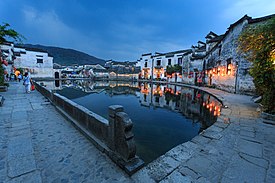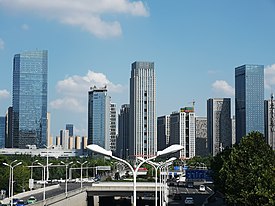Anhui
安徽 | |
|---|---|
| Province of Anhui | |
| Name transcription(s) | |
| • Chinese | 安徽省 (Ānhuī shěng) |
| • Abbreviation | AH / 皖 (Wǎn) |
| • Lower Yangtze Mandarin | Ang1 huei1 Sen3 |
 Map showing the location of Anhui within China | |
| Coordinates: 31°50′N 117°0′E / 31.833°N 117.000°E | |
| Country | China |
| Named for | Anqing and Huizhou |
| Capital (and largest city) | Hefei |
| Divisions | 16 prefectures, 105 counties, 1845 townships |
| Government | |
| • Type | Province |
| • Body | Anhui Provincial People's Congress |
| • CCP Secretary | Liang Yanshun |
| • Congress Chairperson | Han Jun |
| • Governor | Wang Qingxian |
| • Provincial CPPCC Chairperson | Tang Liangzhi |
| • National People's Congress Representation | 111 deputies |
| Area | |
| • Total | 140,200 km2 (54,100 sq mi) |
| • Rank | 22nd |
| Highest elevation | 1,873 m (6,145 ft) |
| Population (2020)[2] | |
| • Total | 61,027,171 |
| • Rank | 9th |
| • Density | 440/km2 (1,100/sq mi) |
| • Rank | 9th |
| Demographics | |
| • Ethnic composition | |
| • Languages and dialects | Lower Yangtze Mandarin, Central Plains Mandarin, Gan, Wu, Huizhou |
| GDP (2023)[3] | |
| • Total | CN¥ 4,705 billion (11th)
US$ 668 billion |
| • Per capita | CN¥ 76,830 (13th)
US$ 10,903 |
| ISO 3166 code | CN-AH |
| HDI (2022) | 0.767[4] (20th) – high |
| Website | www |
| Anhui | |||||||||||||||||||||||||||||||||||
|---|---|---|---|---|---|---|---|---|---|---|---|---|---|---|---|---|---|---|---|---|---|---|---|---|---|---|---|---|---|---|---|---|---|---|---|
 "Anhui" in Chinese characters | |||||||||||||||||||||||||||||||||||
| Chinese | 安徽 | ||||||||||||||||||||||||||||||||||
| Postal | Anhwei | ||||||||||||||||||||||||||||||||||
| |||||||||||||||||||||||||||||||||||
Anhui[a] is an inland province located in East China. Its provincial capital and largest city is Hefei. The province is located across the basins of the Yangtze and Huai rivers, bordering Jiangsu and Zhejiang to the east, Jiangxi to the south, Hubei and Henan to the west, and Shandong to the north. With a population of 61 million, Anhui is the 9th most populous province in China. It is the 22nd largest Chinese province based on area, and the 12th most densely-populated region of all 34 Chinese provincial regions. Anhui's population is mostly composed of Han Chinese. Languages spoken within the province include Lower Yangtze Mandarin, Wu, Hui, Gan and small portion of Central Plains Mandarin.
The name "Anhui" derives from the names of two cities: Anqing and Huizhou (now Huangshan City).[7] The abbreviation for Anhui is Wǎn (皖), corresponding to the historical state of Wan, and is also used to refer to the Wan River and Mount Tianzhu. The provincial government of Anhui includes a Governor, Provincial Congress, the People's Political Consultative Conference, and the Provincial Higher People's Court. Aside from managing local government departments, the Anhui provincial government manages 16 cities, 62 counties, 43 county-level districts and 1,522 townships. Anhui's total GDP ranked 14th among China's 31 province-level regions as of 2022[update].
- ^ "Doing Business in China – Survey". Ministry Of Commerce – People's Republic Of China. Archived from the original on 5 August 2013. Retrieved 5 August 2013.
- ^ "Communiqué of the Seventh National Population Census (No. 3)". National Bureau of Statistics of China. 11 May 2021. Retrieved 11 May 2021.
- ^ "National Data". China NBS. March 2024. Retrieved June 22, 2024.; see also "zh: 2023年安徽省国民经济和社会发展统计公报". anhui.gov.cn. March 20, 2024. Retrieved June 22, 2024.
- ^ "Human Development Indices (8.0)- China". Global Data Lab. Retrieved 23 September 2024.
- ^ "Anhui". Lexico UK English Dictionary. Oxford University Press. Archived from the original on May 18, 2021.
- ^ "Anhui". Merriam-Webster.com Dictionary. Merriam-Webster.
- ^ (in Chinese) Origin of the Names of China's Provinces Archived 2016-04-27 at the Wayback Machine, People's Daily Online.
Cite error: There are <ref group=lower-alpha> tags or {{efn}} templates on this page, but the references will not show without a {{reflist|group=lower-alpha}} template or {{notelist}} template (see the help page).


